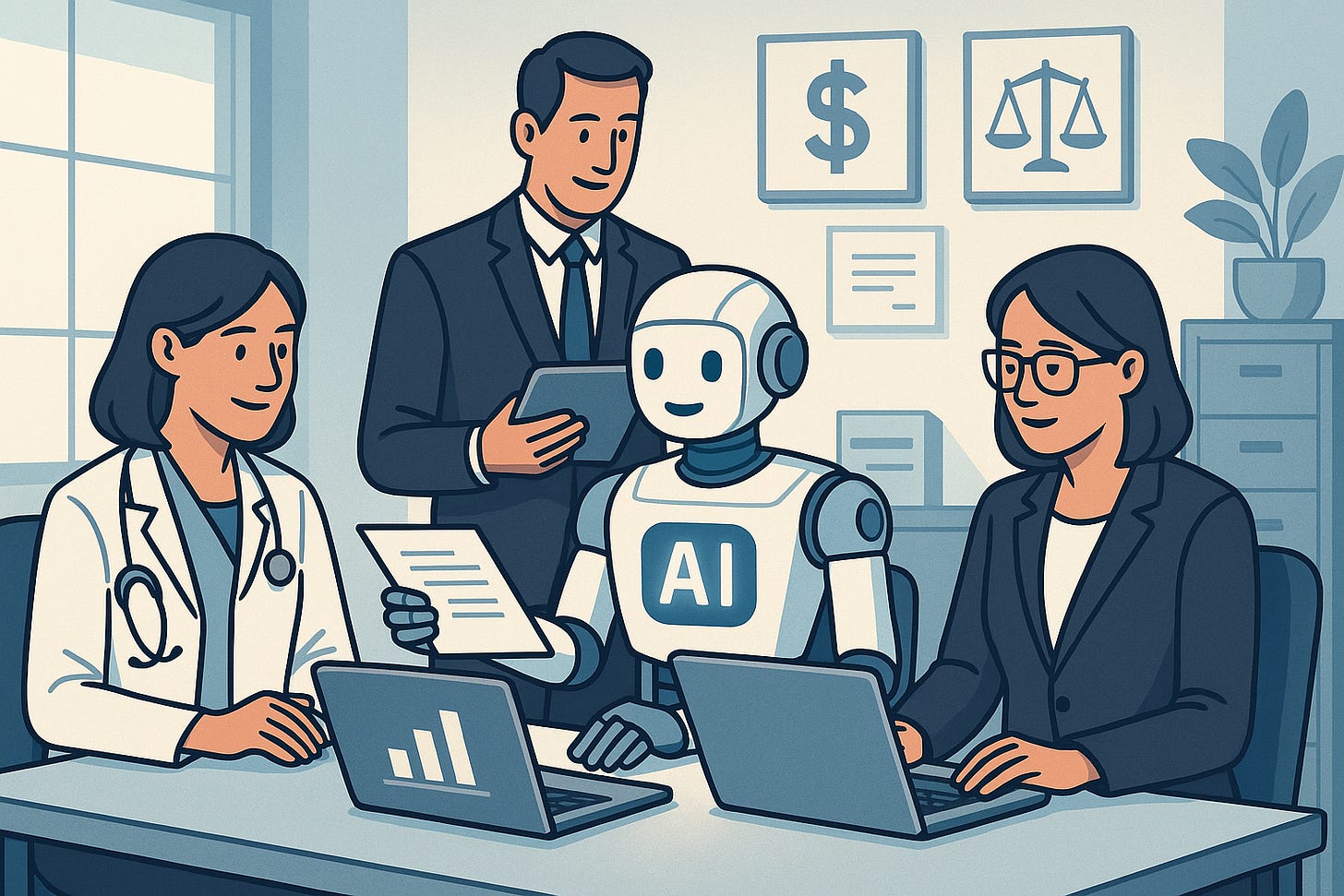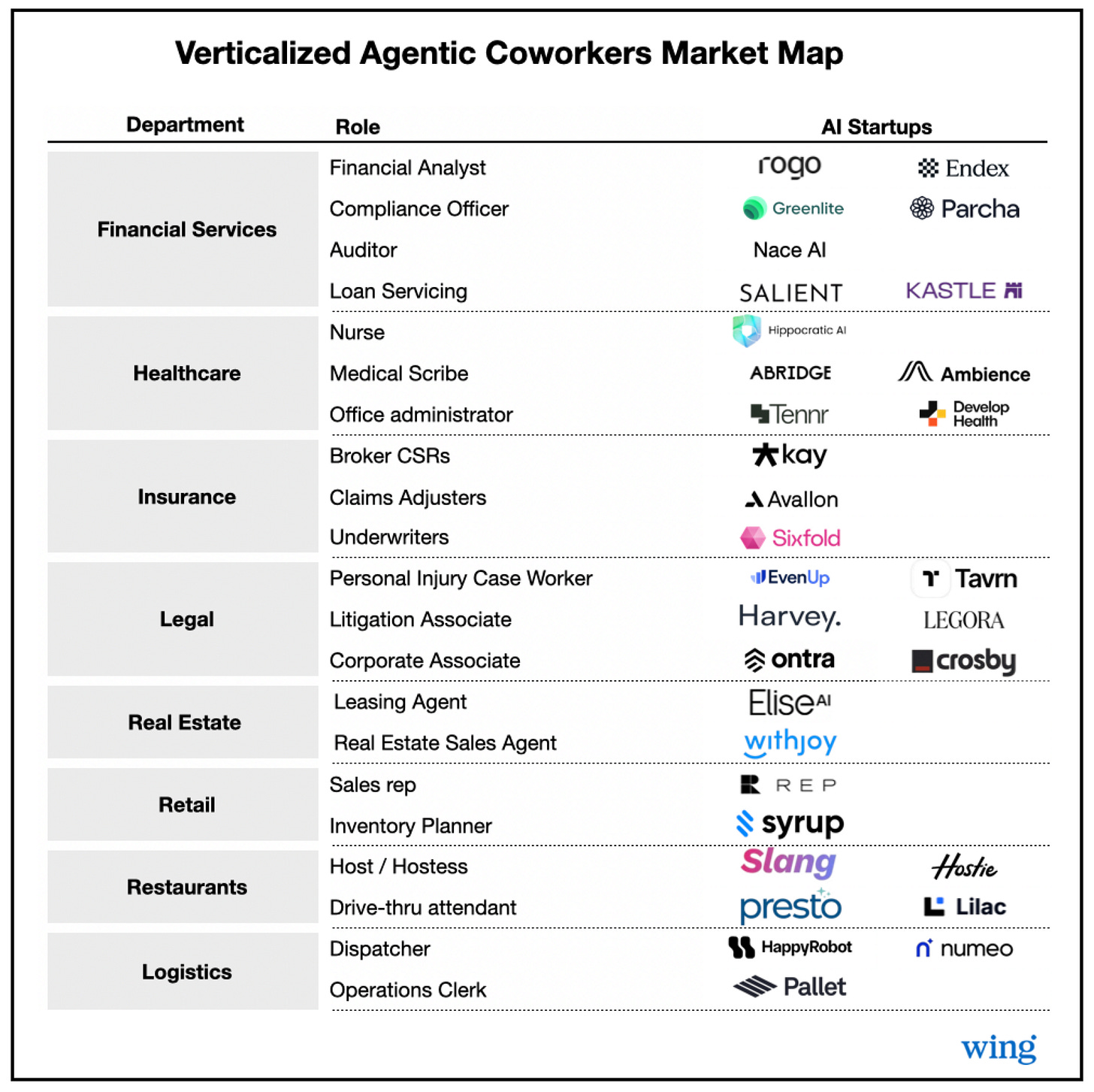The Rise of Verticalized AI Coworkers
AI colleagues and teammates are finding their way to every industry role
This is a weekly newsletter about the business of the technology industry. To receive Tanay’s Newsletter in your inbox, subscribe here for free:
Hi friends,
A few months ago, I wrote about the rise of the agentic workforce, focusing on the agentic coworkers popping up across the key functional roles. Today, I’m breaking down the rise of verticalized agentic coworkers. These are AI agentic coworkers built for specific roles within industry verticals.
What do verticalized agentic coworkers look like?
Modeled on real jobs: Each agentic coworkers is designed to take a subset of core tasks of a specific, high-headcount role. Think insurance claims adjuster, nurse, or compliance officer. The focus is on work that’s high-volume, repetitive and mostly measurable and/or wasn’t getting done because of lack of time (or in job roles with labour shortages).
Integrated into existing workflows: These coworkers plug directly into the software and tools already used by the team. They read and write data, process transactions, and interact with other digital systems.
Task ownership: Unlike generic assistants, these coworkers actually complete work and focus on a subset of tasks that humans in the role perform, ideally taking it off the plate of the human (minus human verification).
Usage-based or Outcome-based pricing: Pricing is usually tied to usage or results (claims processed, reports generated), not just a monthly seat fee.
Human oversight/manager: Most agents still operate with oversight. Humans review outputs, handle exceptions, and step in when needed. The goal is to expand autonomy as trust and performance improve and expand the set of tasks they can perform over time.
Where are we seeing verticalized agentic coworkers?
While still in the early innings, we’re starting to see the first wave of agentic coworkers across most key verticals such as finance, healthcare, legal, insurance, retail, logistics, and many more. A market map is presented below of the key AI-native companies that offer at least some agentic functionality in various vertical roles.
Some of they may fit across multiple roles, but I’ve tried my best to bucket them based on the core role they serve.
Common Wedges for Agentic Coworkers
Most verticalized agentic coworkers wedge into the workflow by starting with a repeatable, high-volume task where cost of errors is relatively small. The most common entry points we’re seeing across verticals are:
Document processing and parsing: Extracting, classifying, and acting on information from contracts, invoices, intake document. This is often the first workflow AI agents can automate end-to-end.
Voice agents for intake, triage, sales, or customer experience: Voice-based agents are making it possible to automate high-volume, front-line interactions. Many AI coworkers handle inbound calls or chats for scheduling, triage, sales qualification, or customer support.
Content creation: Drafting proposals, memos, emails, or reports. Agents trained on industry-specific templates can generate high-quality output that matches the expectations of the role.
Search and information retrieval focused workflows: Surfacing relevant policies, research, or case history in response to specific queries, coupled with forms of content generation. Strong retrieval capabilities are often the backbone of agents in legal, finance, and healthcare, that start of looking like assistants and over time can draft forms, memos, etc
I’ve written this post which goes deeper into these wedges.
Closing Thoughts
Most of the AI coworkers do a fraction of the tasks of a human in their role today. But as models and agentic systems get better over time, they will be able to do more and more tasks and go from junior interns to junior employees to beyond that. It’ll be interesting to see how these companies evolve over time. A few different combination of approaches companies may take:
Do more work within the role: Eat up more and more of the work (different tasks) and increase their value and pricing power over time
Build adjacent coworkers: Build adjacent coworkers for additional roles within the industry to capture more spend within customer base.
Build AI-native systems of action: Leverage the data they’re collecting through doing work to build an AI-native system of record and action within the industry they operate in.




Why is there a robot in your animated hero image? Can we stop with the lazy and wrong robot images for AI stories already?
AI is just code and data. Robotics is control systems and hardware.
Robotics is NOT AI and vice versa. If you can't distinguish the difference, I have lost all interest in your opinion. Please don't do this.
I have 5 already.